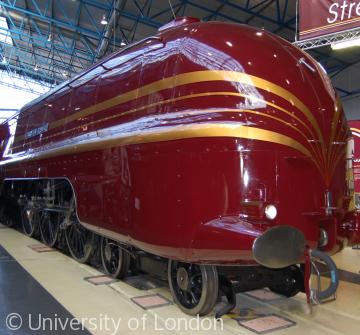Railways
 The Duchess of Hamilton, a streamlined LMS Coronation class locomotive which resides in the National Railway Museum at York
The Duchess of Hamilton, a streamlined LMS Coronation class locomotive which resides in the National Railway Museum at YorkIn the 21st century, railways are an integral part of the global transport network, carrying people and freight across countries, continents and since 1994 under the English Channel. Although railways can be found across the globe, their story can be traced back to the coalfields of north-east England in the first quarter of the 19th century.
George Stephenson is remembered as the father of the railways but as early as 1801, the Cornish engineer, Richard Trevithick had successfully harnessed the potential power of steam at high pressure, allowing for the creation of engines which were far smaller and lighter than the stationary beam engines of Boulton & Watt, common among the mines of Cornwall. Lighter, portable engines opened up the possibility of translating steam power into locomotion and by 1803, Trevithick had successful built and run both a road locomotive and a locomotive which ran of cast-iron rails. But Trevithick was unable to solve the problem of the brittle rails cracking under the weight of the heavy engine and ceased working on locomotives.
On the profitable coalfields of the north-east, won coal was transported from the pitheads by horse drawn wagons, pulled on wooden rails. Alive to the possibility of using steam power to improve the transportation of coal, colliery engineers like George Stephenson began to construct steam locomotives to move coal. By 1814 Stevenson had built two locomotives for the Killingworth Colliery. He chose a gauge of 4 feet 8 ½ inches (the gauge of the waggonways in the area) and this gauge became the standard for railways around the world.
In 1821, Stephenson opened the first Locomotive works, Stephenson and Son, in order to construct the world’s first public railway, connecting the towns of Stockton and Darlington with the River Tees. He chose to use wrought, rather than cast iron rails, and so solved the problem which had plagued Trevithick and other engineers and dramatically expanded the railway's potential.
After the successful opening of the Stockton and Darlington Railway, George Stevenson surveyed a line to connect the cotton spinning centre of Manchester with the port city of Liverpool. Despite a bitter struggle with the canal lobbyists, Stephenson gained Parliamentary assent for his line and began construction. A series of trials were held at Rainhill, near Liverpool in 1829, to decide which locomotive would operate the Liverpool Manchester railway. Three locomotives, Rocket (designed by Stephenson’s son Robert), Sans Pereil and Novelty took part, with Rocket emerging victorious. The line opened on 15th September 1830, becoming the world’s first passenger line. That day also saw the worlds first railway fatality, when former President of the Board of Trade, William Huskisson hit and killed by Rocket.
In the 40 years after the Liverpool Manchester Railway opened, 1000s of miles of track were laid, lines crossed and re-crossed the country, occasionally linking the same towns as rival companies fought for business. Fortunes were made and lost during two periods of ‘Railway Mania’ in Britain during the 1840s and 1860s which the saw the creation of the railway network and the major stations and termini still in use today and also saw railway technology exported around the world. All companies built to Stephenson’s standard gauge, with the exception of I.K.Brunel who chose a 7 foot broad gauge for his Great Western Railway to Bristol. Although this gave a smoother and faster service, the line was converted to standard gauge between 1868 and 1892.
The heyday of the railways in Britain occurred during the 1920s and 1930s. On the 1st January 1923, the 123 separate companies which operated the British railway network were consolidated to form the ‘Big Four’, Great Western Railway, London and North Eastern Railway, London, Midland and Scottish Railway and Southern Railway, with each given a quarter of the network to run. Freed from direct competition for passengers the companies concentrated on advances in speed and efficiency.
The GWR’s Castle class locomotives were the fastest and most efficient of the 1920s, but by 1937, the LNER’s A4 Pacifc class and the LMS’s Princess Coronation class were leading the quest for greater speed, culminating in the iconic Mallard (an A4 Pacific) setting a speed record that no steam engine has ever surpassed.
The railways proved vital during wartime, moving both men and munitions, with numerous additional narrow gauge lines (usually 2ft) built for military purposes. After the Second World War, the railways were over-used and under-maintained and the Labour government passed the Transport Act in 1947, which nationalised the railways and formed British Railways (later British Rail).
From 1955, the expensive and labour intensive steam locomotives were gradually replaced by diesel electric engines during a 20 year period of modernisation. As part of this, Dr Richard Beeching wrote his infamous; ‘Reshaping of British Railways’ report, which in the face of increasing competition from the motorways and private cars, recommended radical cuts to the railway network that eventually saw around 5,000 miles of track abandoned. Although drastically reducing the network, the cuts did inadvertantly save a number of the redundant steam locomotoves which were destinted to be cut up for scrap, which found homes with steam preservation societies on the abandoned stretches of track.
In 1993, the Conservative government privatised British Rail and once again rail travel was provided by a number of companies, each with their own sections of the network and in November 2007, the Channel Tunnel Rail Link (branded High Speed 1) became the first new mainline railway in Britain for over a century.




